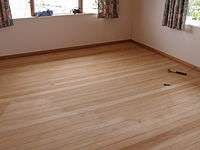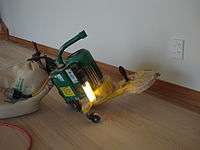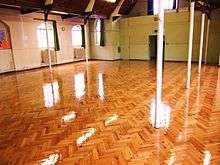Floor sanding
Floor sanding is the process of removing the top surfaces of a wooden floor by sanding with abrasive materials.



A variety of floor materials can be sanded, including timber, cork, particleboard, and sometimes parquet. Some floors are laid and designed for sanding.[1] Many old floors are sanded after the previous coverings are removed and suitable wood is found hidden beneath. Floor sanding usually involves three stages: Preparation, sanding, and coating with a protective sealant.
Machines
All modern sanding projects are completed with specialized sanding machines. The majority of material is removed by large 220 volt belt or drum sander. Belt sanders are preferred for the continuous sand paper belt design to prevent sanding machine marks in floors. The belt sander was invented by Eugen Laegler in 1969 out of Güglingen, Germany. 90% of the area can be reached with the belt/drum sander. The remaining 10% left such as edges, corners, under cabinets, and stairs, are sanded by an edge sanding machine. A finishing machine known as a multi disc sander or buffer is then used for the final sanding steps.
Process
Preparation is the first stage of the sanding process. All nails which protrude above the boards are punched down. Nails can severely damage the sanding machines which are being used. Staples or tacks used to fasten previous coverings (if any) are removed to reduce the possibility of damage. Some brands or types of adhesives which have been used to secure coverings may need to be removed. Some adhesives clog papers and running gear of the machines used, and some can even make sanding impossible.
After the floor is prepared, the sanding begins. The first cut is done with coarse-grit papers to remove old coatings and to make the floor flat. The differences in height between the boards are removed. The large sanders are used across the grain of the timber. The most common paper used for the first cut is 40 grit.[2] content, so wearing a suitable respirator mask[3] is recommended.
Issues
Sanding removes all patina, and can change the character of old floors. The result does not always suit the character of the building.
Sanding old boards sometimes exposes worm eaten cores, effectively ruining the floor's appearance. This can reduce the sale price, or even cause the floor to require replacement.
Sanding removes material, and timber floors have a limit to how much they can be sanded.
References
- Newnes (1984). Newnes all colour reference DIY and home improvement. London: Newnes Books.
- Volatile organic compound
- Respirator
